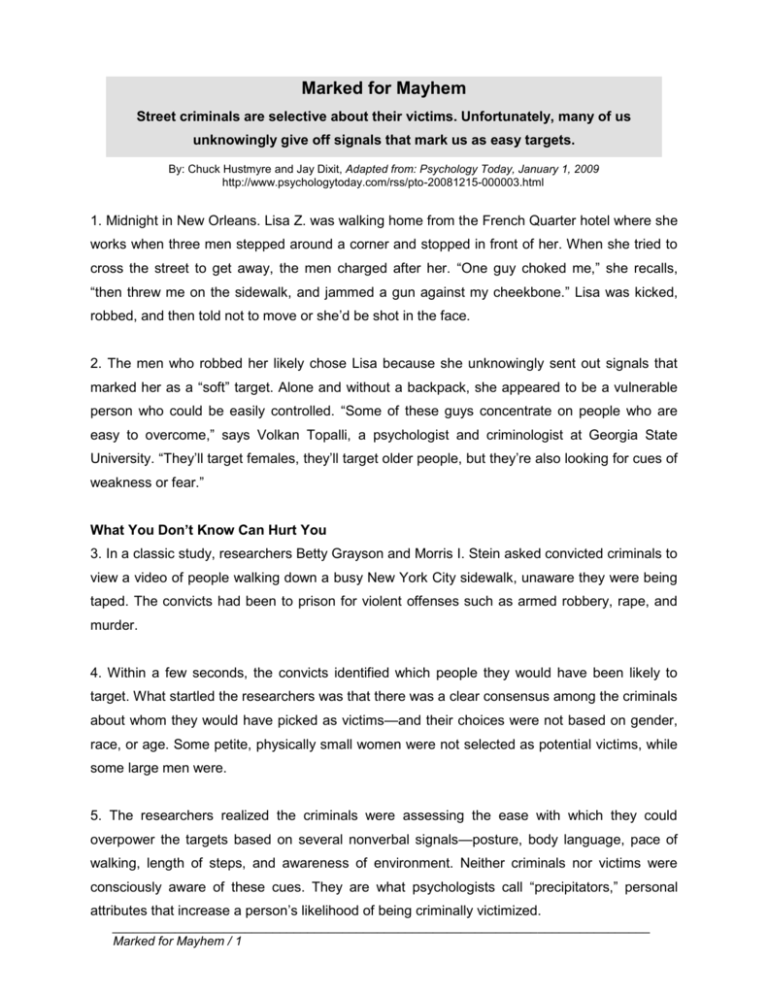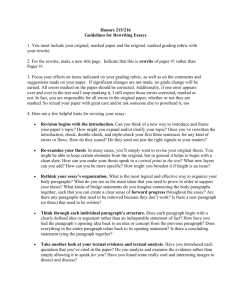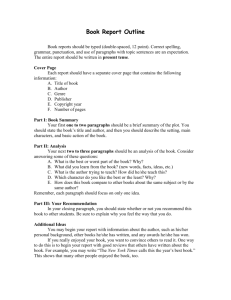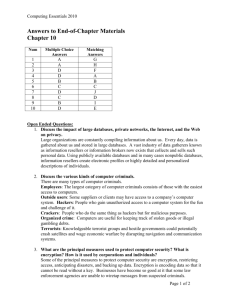
Marked for Mayhem
Street criminals are selective about their victims. Unfortunately, many of us
unknowingly give off signals that mark us as easy targets.
By: Chuck Hustmyre and Jay Dixit, Adapted from: Psychology Today, January 1, 2009
http://www.psychologytoday.com/rss/pto-20081215-000003.html
1. Midnight in New Orleans. Lisa Z. was walking home from the French Quarter hotel where she
works when three men stepped around a corner and stopped in front of her. When she tried to
cross the street to get away, the men charged after her. “One guy choked me,” she recalls,
“then threw me on the sidewalk, and jammed a gun against my cheekbone.” Lisa was kicked,
robbed, and then told not to move or she’d be shot in the face.
2. The men who robbed her likely chose Lisa because she unknowingly sent out signals that
marked her as a “soft” target. Alone and without a backpack, she appeared to be a vulnerable
person who could be easily controlled. “Some of these guys concentrate on people who are
easy to overcome,” says Volkan Topalli, a psychologist and criminologist at Georgia State
University. “They’ll target females, they’ll target older people, but they’re also looking for cues of
weakness or fear.”
What You Don’t Know Can Hurt You
3. In a classic study, researchers Betty Grayson and Morris I. Stein asked convicted criminals to
view a video of people walking down a busy New York City sidewalk, unaware they were being
taped. The convicts had been to prison for violent offenses such as armed robbery, rape, and
murder.
4. Within a few seconds, the convicts identified which people they would have been likely to
target. What startled the researchers was that there was a clear consensus among the criminals
about whom they would have picked as victims—and their choices were not based on gender,
race, or age. Some petite, physically small women were not selected as potential victims, while
some large men were.
5. The researchers realized the criminals were assessing the ease with which they could
overpower the targets based on several nonverbal signals—posture, body language, pace of
walking, length of steps, and awareness of environment. Neither criminals nor victims were
consciously aware of these cues. They are what psychologists call “precipitators,” personal
attributes that increase a person’s likelihood of being criminally victimized.
_____________________________________________________________________________
Marked for Mayhem / 1
6. The researchers analyzed the body language of the people on the tape, and identified several
aspects of behavior that marked potential victims as good targets. One of the main precipitators
is a walking style that lacks “interactional synchrony” and “wholeness.” That is, perpetrators
notice a person whose walk lacks organized movement. Criminals view such people as less
self-confident—perhaps because their walk suggests they are less athletic and fit—and are
much more likely to exploit them.
7. Just like animals in the wild, armed robbers often attack the slowest in the group. People who
drag their feet, shuffle along, or exhibit other unusual gaits are targeted more often than people
who walk fast and smoothly.
8. That criminals are aware of cues of vulnerability makes sense given that most criminals,
especially murderers, are looking for people who will be easy to control. Even rape is motivated
less by sex and more by the desire for control and power.
9. Sexual predators in particular look for people they can easily overpower. “The rapist is going
to go after somebody who’s not paying attention, who looks like they’re not going to put up a
fight, who’s in a location that’s going to make this more convenient,” says Tod Burke, a
criminologist at Radford University in Virginia.
10. “If I had the slightest inkling that a woman wasn’t someone I could easily handle, then I
would pass right on by. Or if I thought I couldn’t control the situation, then I wouldn’t even mess
with the house, much less attempt a rape there,” says Brad Morrison, a convicted sex offender
who raped 75 women in 11 states and who’s quoted in Predators: Who They Are and How to
Stop Them, by Gregory M. Cooper, Michael R. King, and Thomas McHoes.
11. “Like, if they had a dog, then forget it. Even a small one makes too much noise. If I saw a
pair of construction boots, for example, out on the porch or on the landing, I walked right on by.
In fact, I think if women who live alone would put a pair of old construction boots—or something
that makes it look like a physically fit manly-type of guy lives with them—out in front of their
door, most rapists or even burglars wouldn’t even think about trying to get into their home.”
12. Distraction is another cue criminals look for. Some people think talking on a cell phone
enhances their safety because the other person can always summon help if there’s trouble—but
_____________________________________________________________________________
Marked for Mayhem / 2
experts disagree. Talking on a phone or listening to an iPod is a distraction, and armed robbers
are looking for distracted victims. “Not paying attention, looking like a tourist—having the map
out, looking confused—absolutely makes people more vulnerable,” Burke says.
13. Being aware of your surroundings, however, may not help much if you don’t know what to
pay attention to. James Giannini of Ohio State University discovered something shocking:
Women who are the victims of rape tend to be less able than average to interpret nonverbal
facial cues—which may make them unaware of the warning signs of hostile intent and more
likely to enter or stay in dangerous situations.
14. The same team also found that rapists tend to be more able than average to interpret facial
cues, such as a downward gaze or a fearful expression. It’s possible this skill makes rapists
especially able to spot passive, submissive women. One study even showed that rapists are
more empathetic toward women than other criminals—although they have a distinct empathy
gap when it comes to their own victims. A highly aware rapist and a woman who’s not aware of
hostile body language make a dangerous combination.
15. Even personality plays a role. Conventional wisdom holds that women who dress
provocatively draw attention and put themselves at risk of sexual assault. But studies show that
it is women with passive, submissive personalities who are most likely to be raped—and that
they tend to wear body-concealing clothing, such as high necklines, long pants and sleeves,
and multiple layers. Rapists can accurately identify submissive women just by their style of
dress and other aspects of appearance. Typical submissive body language, such as downward
gaze and slumped posture, may even be misinterpreted by rapists as flirtation.
16. Drinking and drug use, not surprisingly, also mark a person as a potential victim. “It’s a
robber’s dream to knock a drunk down and take what they’ve got,” says former Ohio detective
Stacy Dittrich.
17. That goes double for sexual assault. Drunken people not only appear more vulnerable,
they’re also especially likely to place themselves in dangerous situations. Alcohol decreases
people’s ability to evaluate the consequences of their actions and distorts their ability to predict
how others perceive them. And women who are intoxicated, studies show, tend to be animated,
giving off signals that sexual offenders may misinterpret as sexual interest.
_____________________________________________________________________________
Marked for Mayhem / 3
The Resentment Motive
18. Many armed robbers have a chip on their shoulders and view life as inherently unfair, says
criminologist Richard Wright, a professor at the University of Missouri at St. Louis and co-author
of Armed Robbers in Action: Stickups and Street Culture. As a result, they often see someone
else’s success as a reminder of their own failure. Worse still, they interpret outward signs of
another’s success as a personal insult. “When they see people flaunting their wealth or driving
fancy cars, they see that as an attempt to put them down,” Wright says.
19. For this reason, robbers are especially likely to target people who are flaunting material
possessions or even just displaying a superior attitude. Street predators have their own word for
such behavior—“flossing”—and it maddens them. “It’s a very visible reminder of their situation,”
Wright adds, “of being poor, that they’ve got nothing in their pockets.”
20. From the perspective of the perpetrator, the robbery balances the scales, at least
temporarily. “It’s a restoration of justice,” Wright explains. “’You were putting me down. Now
guess what? I’m going to put you down. You’ve got all that. I’m going to take it away.’”
21. Sometimes, however, this may be just moral nonsense robbers use to justify their own
behavior. “In some cases, offenders need to invent motivation to commit the crime,” Topalli
says. Somehow, they need to justify their actions. “It’s better to rob people who deserve it.”
22. In the backwards universe that resentment builds in the brain, many armed robbers view
themselves as the real victims in the world, a world in which the rich take their wealth from the
poor.
Reducing the Risk
23. Grayson, co-author of the classic study on body language and exploitability, believes people
can be taught how to walk in a confident way that reduces their risk of assault. To reduce the
chances of becoming a victim, you can’t look like a victim. “Walk in an alert fashion, walk with
purpose, with your shoulders held back,” advises Topalli.
24. Even better, avoid placing yourself in dangerous situations and stay aware of your
surroundings at all times. Location is a key factor in street crime, particularly in cases of sexual
assault. Criminals prefer sites that are likely to have few witnesses and little chance of being
caught. Plan routes that avoid such locations.
_____________________________________________________________________________
Marked for Mayhem / 4
25. And while you’re at it, don’t even talk to strangers on the street in isolated locations. One
warning sign that you may be about to be robbed or attacked is the approach of a stranger on
the street. The person may try to engage you in conversation. He may ask for the time,
directions, bus fare, or try to tell you about a nice club or restaurant just around the corner.
26. Calvin Donaldson, who’s been in prison in Louisiana for the last 28 years after robbing a
couple in the French Quarter who asked him for directions, offers some advice: “Once you stop
and let this guy engage you in conversation, you’re opening yourself up,” he says. “Some
people you don’t talk to. You just keep going.”
27. How do you survive unharmed if you find yourself targeted? Cooperate. “They’re not going
to hurt you unless they need to,” says New Orleans Police Department psychologist James
Arey. Convicted armed robber Darryl Falls, who admits to committing more than 100 robberies,
agrees. “The quicker you comply and give them your goods,” he says, “the quicker they’re out of
your face.”
28. Some of Falls’ victims tried to conceal jewelry to which they had an emotional attachment—
wedding rings, for example. “I understand the sentimental value,” he says. “But you can get that
back. You can’t get your life back.”
_____________________________________________________________________________
Marked for Mayhem / 5
Exercises adapted from Dr. Osnat Chen
Marked for Mayhem – Exercises
I. Pre-Reading
Look at the pictures below. Which people are more likely to be attacked by a criminal on the
street? Which people are less likely to be attacked? Compare your choices with a partner.
_____________________________________________________________________________
Marked for Mayhem / 6
II. Global Reading
1. Read the title and subtitle.
a. What does it mean to be “marked for mayhem”?
___________________________________________________________________
b. Who is marked for mayhem?
___________________________________________________________________
2. Read the introduction of the article, and answer the following questions.
a. Why does the writer tell us about Lisa Z.?
___________________________________________________________________
___________________________________________________________________
b. Why was Lisa considered an easy target?
Because she was _____________________________ and didn’t have a
______________________________, the criminals thought that she was
__________________________________________________________________.
3. The article is divided into sections by subtitles. Read the subtitles, and predict the
content of each section.
Subtitle
Prediction
What You Don’t Know Can Hurt You
The Resentment Motive
Reducing the Risk
4. Skim paragraphs 6-17.
a. What is the topic of these paragraphs?
___________________________________________________________________
b. Which aspects of behavior mark potential victims as good targets for criminals?
i. __________________________________________________________________
ii. _________________________________________________________________
iii. _________________________________________________________________
iv. _________________________________________________________________
v. _________________________________________________________________
vi. _________________________________________________________________
_____________________________________________________________________________
Marked for Mayhem / 7
III. Close Reading Questions
Paragraphs 3-17
1. Read paragraphs 3-5, and complete the chart below about the research study.
Participants
Procedure
(What did the participants do?)
1. _________________________________________
___________________________________________
2. _________________________________________
___________________________________________
Results
Which findings were surprising
to the researchers? (Give the
idea; not the example.)
1. _________________________________________
___________________________________________
2. _________________________________________
___________________________________________
Purpose of the research
(Infer it based on paragraph 5)
To find out __________________________________
___________________________________________
___________________________________________
2. a. What are “precipitators” (par. 5)? _______________________________________
___________________________________________________________________
b. Did the criminals and victims realize the effect of precipitators? YES / NO
Quote a sentence from the text to support your answer.
___________________________________________________________________
3. Complete the following sentences to explain the first nonverbal cue that criminals
use to choose victims.
The walking style of potential victims lacks organized movement. This is referred to
as a style that doesn’t have _______________________________________ and
__________________________________. Perpetrators possibly mark these people
as easy targets since they consider these people to be _______________________
______________________________________.
_____________________________________________________________________________
Marked for Mayhem / 8
4. a. What are criminals compared to in paragraph 7? __________________________
b. How are they similar? (Complete the sentence.)
They both ___________________________________________________________
5. Which idea do Brad Morrison’s statements in paragraphs 10-11 illustrate?
___________________________________________________________________
___________________________________________________________________
6. According to experts, why doesn’t talking on a cell phone enhance peoples’ safety?
___________________________________________________________________
___________________________________________________________________
7. What were Giannini’s findings?
a. _________________________________________________________________
b. _________________________________________________________________
8. Complete the following sentences according to the information in paragraph 15.
Although most people think that women who dress
___________________________________ are at risk of being attacked, in fact
women who wear ________________________________________________ are
more at risk because rapists see them as __________________________________
Paragraphs 18-22
9. Many armed robbers believe life is unfair. What are 2 consequences of this belief?
a. _________________________________________________________________
b. _________________________________________________________________
10. a. What is “flossing”? __________________________________________________
___________________________________________________________________
b. Why does flossing bother street predators?
___________________________________________________________________
___________________________________________________________________
Paragraphs 23-28
11. (Par. 23-26) Based on these paragraphs, make a list of advice for people on how to
avoid being targeted by a criminal.
___________________________________________________________________
___________________________________________________________________
___________________________________________________________________
___________________________________________________________________
_____________________________________________________________________________
Marked for Mayhem / 9
12. What is the purpose of paragraphs 27-28?
___________________________________________________________________
13. What is the author’s MAIN purpose in the article?
a. to make the reader aware of cues that criminals use to help them choose their
victims
b. to present evidence suggesting that criminals can easily take control of their
victims
c. to show that easy targets are often distracted and unaware of their surroundings
d. to list the reasons why criminals decide to commit crimes in spite of the fact that it
is risky
IV. General Ideas and Support
Write the number of the example on the right next to the idea that it illustrates.
Examples
Ideas
1. (par. 4) Some petite, physically small
women were not selected as potential
victims, while some large men were.
_____ a. Many robbers interpret outward
signs of another’s success as a
personal insult.
2. (par. 7) People who drag their feet,
shuffle along, or exhibit other unusual gaits
are targeted more often than people who
walk fast and smoothly.
_____ b. Criminals’ choices were not
3. (par. 11) “Like, if they had a dog, then
forget it. Even a small one makes too
much noise. If I saw a pair of construction
boots, for example, out on the porch or on
the landing, I walked right on by.”
______ c. Sexual predators…look for
4. (par. 18) When robbers see people
flaunting their wealth or driving fancy cars,
they see that as an attempt to put them
down.
______ d. Armed robbers often attack the
based on gender, race, or age.
people they can easily overpower.
slowest in the group.
V. Post Reading Activity
Will you change your behavior after reading this article? If so, in what way?
______________________________________________________________________
______________________________________________________________________
_____________________________________________________________________________
Marked for Mayhem / 10
Marked for Mayhem – Vocabulary
Find and underline the following words in the text.
Word
Also in par. #
Word
Also in par. #
Subtitle
Paragraph 8
1. victim (n.)
12. desire (n./ v.)
2. target (n./ v.)
2
Paragraph 10
Paragraph 3
13. attempt (v./ n.)
3. convict (n./ v.)
4. offense (n.)
Paragraph 13
offend (v.) / offender (n.)
14. surroundings (n.)
surround (v.)
Paragraph 4
15. interpret (v.)
5. Identify (v.)
cf. misinterpret
15
6. gender (n.)
Paragraph 14
Paragraph 5
16. Submissive (adj.)
7. Nonverbal (adj.)
cf. verbal
submit (v.)
8. likelihood (n.)
likely (adj.)
Paragraph 15
17. Assault (n./ v.)
6
Paragraph 6
Paragraph 17
9. Perpetrator (n.)
18. distort (v.)
Paragraph 7
Paragraph 19
10 attack (v. / n.)
19. display (v.)
11. exhibit (v.)
20. superior (adj.)
Exercise 1: Cloze
Fill in the empty blanks in the following sentences by using the words in the list below:
offenses
convicted
likely
gender
nonverbal
victims
identify
perpetrator
target (v.)
1. Studies show that a large percentage of criminals are ________________________
of further _________________________ after they are released from prison.
_____________________________________________________________________________
Marked for Mayhem / 11
2. When asked to describe their _________________________, criminals say they
_________________________ vulnerable people who can be easily controlled.
3. The fact that physically small women were not selected as potential victims while
some large men were shows that criminals’ choices are not based on
_________________________ or on physical appearance.
4. Another word for an offender is a _________________________.
5. Body language, pace of walking, and awareness of the environment are
_________________________ signals which criminals assess in their potential
victims.
6. Criminals are able to _________________________ people that they can easily
overpower.
7. Individuals who are aware of their surroundings are less ______________________
to be attacked.
Exercise 2: Synonyms or Antonyms?
Decide whether the words in each of the following pairs are synonyms or antonyms:
1. likelihood _______________ probability
2. attempt
_________________ try
3. superior ________________ inferior
4. assault _________________ attack
5. display _________________ show
6. surroundings ____________ environment
7. submissive ______________ assertive
Exercise 3: Finding Synonyms
Find words in the article which mean the same as the following words:
1. found guilty of (par. 3)
_________________
2. show, display (par. 7)
_________________
3. want, wish (par. 8)
_________________
4. figure out, give meaning to (par. 13)
_________________
5. twist, give a false account of (par. 17) _________________
_____________________________________________________________________________
Marked for Mayhem / 12







